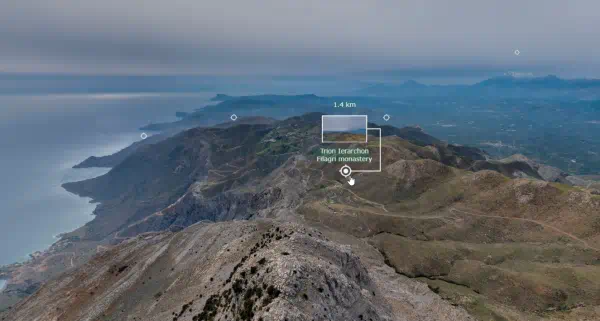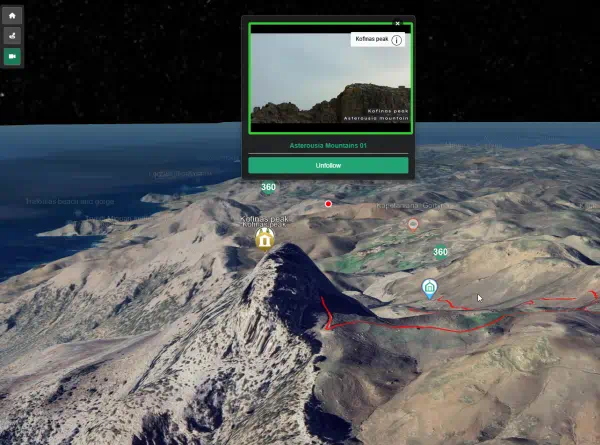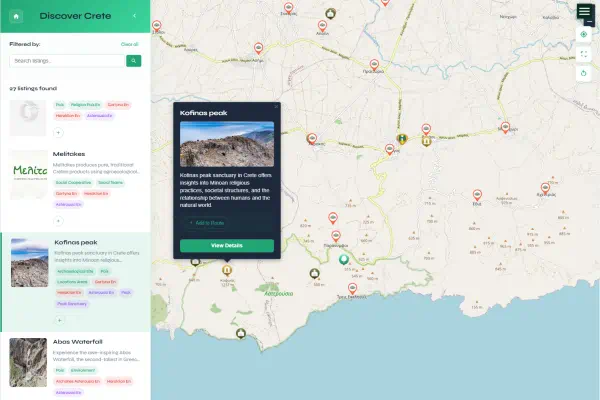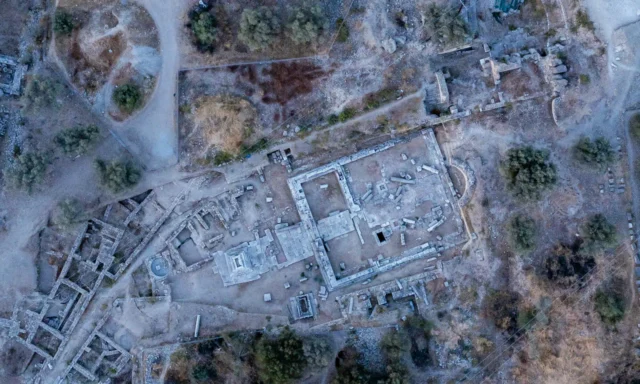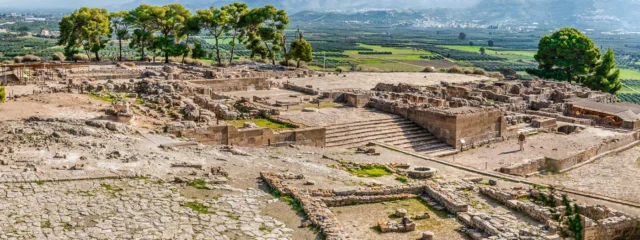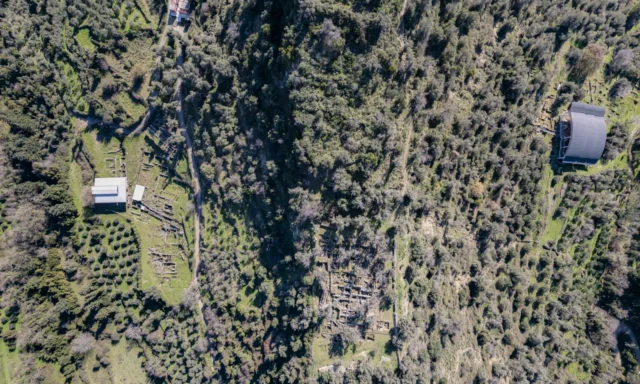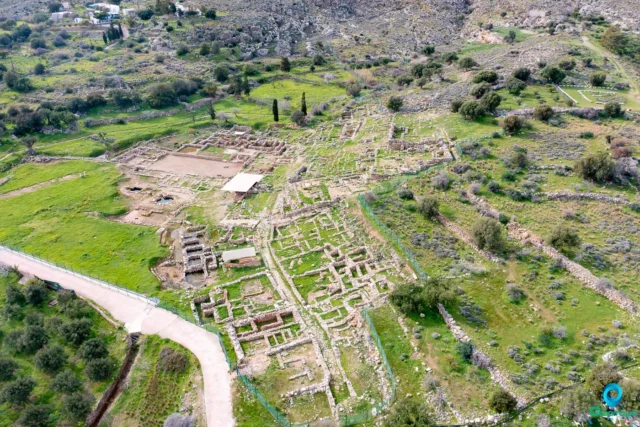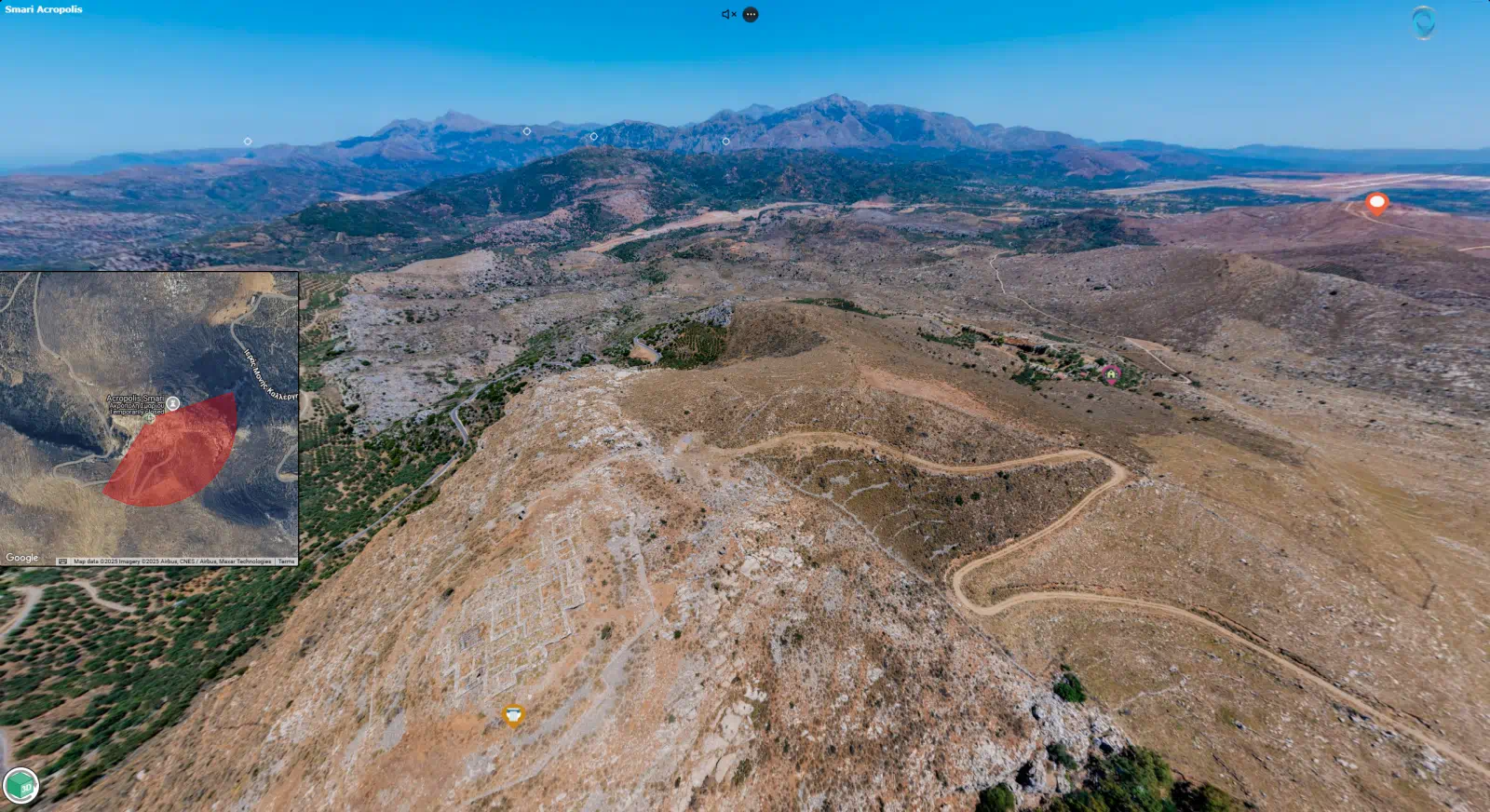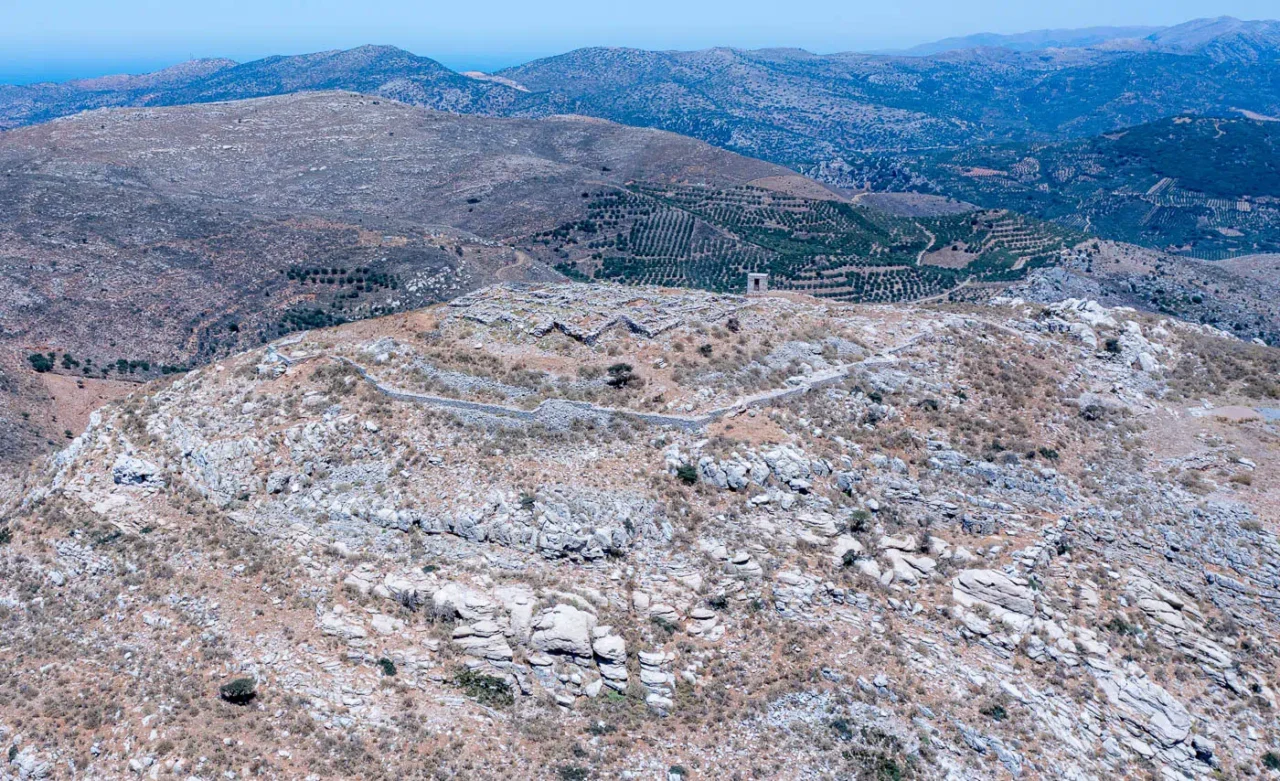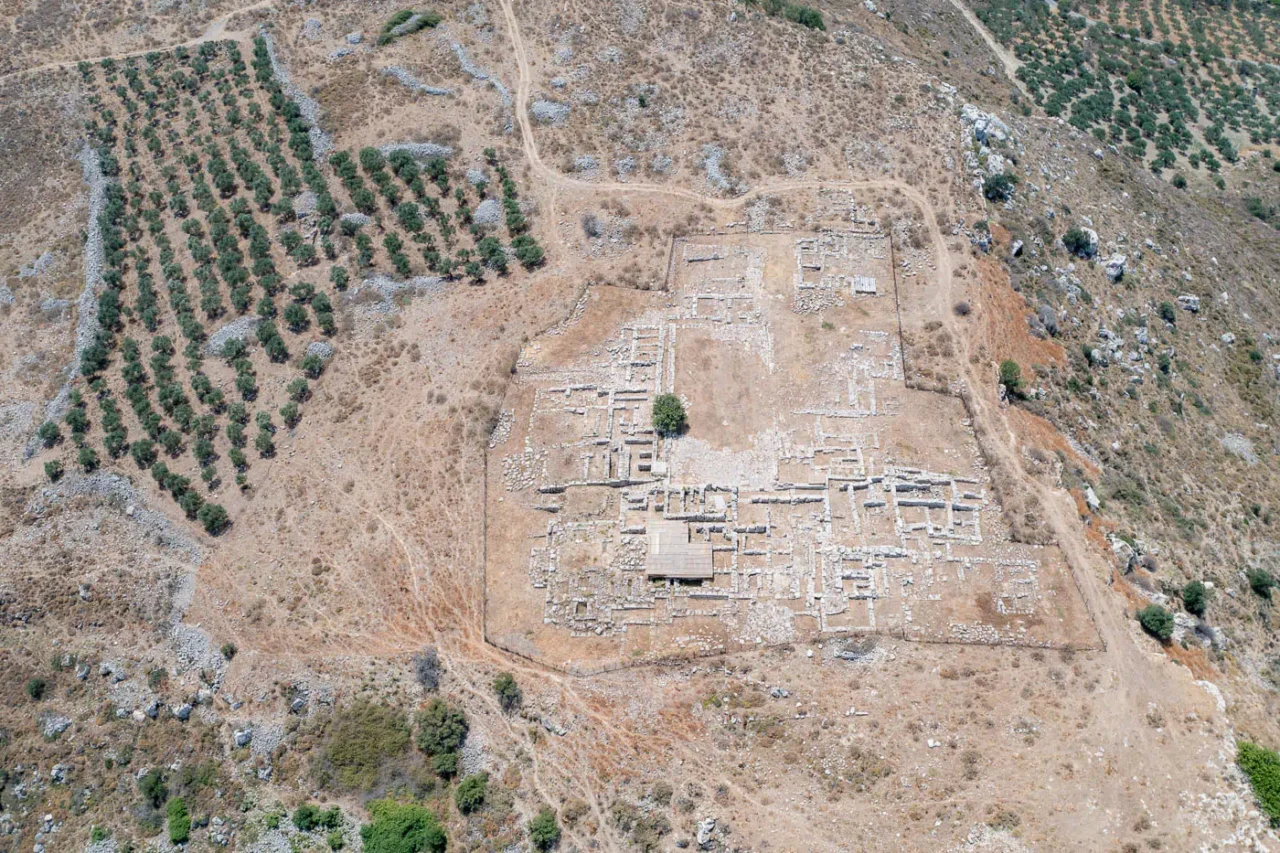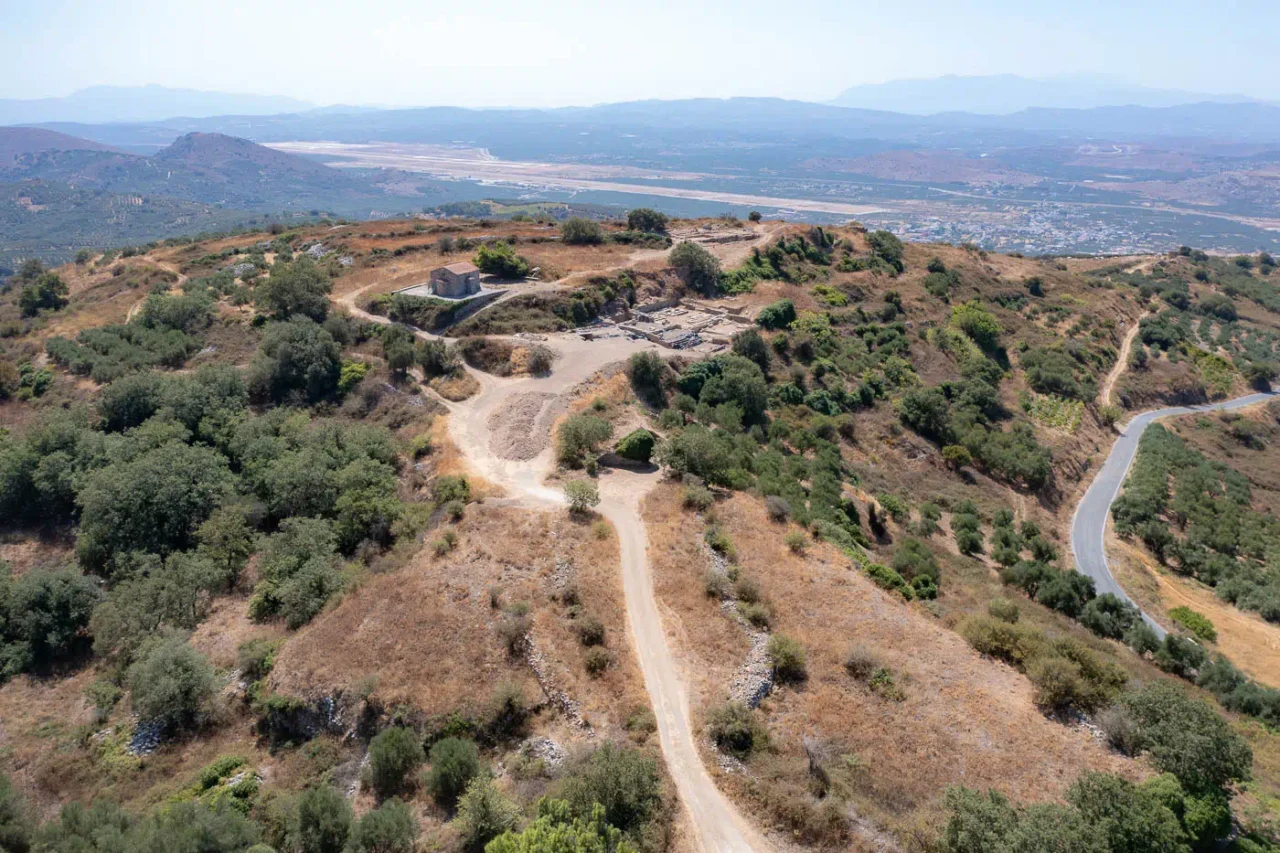Join the community effort to save this unique world heritage site by following the official support group on Facebook for the latest updates and actions.
Add your voice to the global call: Sign the Avaaz petition now to demand the full protection of the Papoura monument and prevent its irreversible damage.
A Discovery of “Unique” Significance
The Archaeological Context: Papoura Hill in the Pediada Landscape
Papoura Hill is part of the Pediada plain, a region in central-eastern Crete with a high concentration of continuous archaeological sites. This area included important Minoan centers like the palace of Galatas, ancient Lyktos, and the acropolis of Smari. The discovery on Papoura Hill provides important, and earlier, information about the area’s organization and social structure at the beginning of the Minoan palatial period.
The monument’s location is strategically important. It is on top of a hill that overlooks a large part of the plain, a position that was deliberately selected. The archaeologist and Honorary Ephor of Antiquities, Antonis Vasilakis, has analyzed the importance of such locations in ancient Crete. He notes that place names such as Pyrgos, Vigla, Kasteli, Kor(y)phi, and Papouri or Papoura, often mark high points used to control territory, for defense, and for communication. These locations formed a network that let Minoan communities watch over routes, manage the movement of goods, and communicate, often using fire signals known as fryktories.
The location of the Papoura monument on a high, strategic point is consistent with this interpretation. The location was chosen for strategic reasons by the Minoans 4,000 years ago, similar to how it was recently selected by aeronautical engineers for the new airport’s radar. This connection between the ancient and modern uses of the site creates a conflict. The same geographical needs for surveillance, control, and communication have led modern technology to be placed at the same location as the ancient site.
Architecture, Chronology, and Material Culture
The excavation by the Ephorate of Antiquities of Heraklion has uncovered an architectural complex that the Ministry of Culture has described as “unique in Minoan archaeology”. The building’s large scale and architectural design are not seen elsewhere in the Aegean during the Bronze Age. Its technical details are important for understanding the structure.
The construction is a circular building with a diameter of 48 to 50 meters, covering an area of about 1,800 square meters. It is made of eight concentric stone rings built at different heights. The rings have an average thickness of 1.40 meters, and their maximum remaining height is 1.7 meters.
In the center, the rings form a circular building (Zone A) that is 15 meters in diameter. Its interior is 9 meters in diameter and is divided into four quadrants. The construction suggests a corbelled design, where the walls sloped inward as they rose, possibly forming a vaulted or conical roof. This central area is surrounded by a second main area (Zone B), which is about 6.9 meters wide. In this zone, radial walls cross the lower rings to form smaller spaces. These spaces were connected by narrow openings, creating what has been described in announcements as a “labyrinthine” structure. Two possible main entrances to the central zones have been found on the southwest and northwest sides.
The monument’s main period of use is dated between 2000 and 1700 BCE, during the Protopalatial period (Middle Minoan I-II). This indicates it was built and used at the same time as the first major palatial centers of Crete, such as Knossos and Phaistos. The discovery of Neopalatial pottery in the destruction layer suggests its use continued into the later palace period, showing its continued importance for local communities.
The movable artifacts, while the excavation is still in progress, offer initial clues about the site’s function. The lack of evidence for permanent housing, along with the discovery of many animal bones, leads archaeologists to believe the monument was used periodically for rituals. It was likely a shared building where nearby communities gathered to conduct ceremonies that involved eating, drinking, and possibly sacrifices.
Characteristic | Specification |
Location | Papoura Hill, Kasteli Pediados, Crete |
Altitude | 494 meters |
Diameter | ~48-50 meters |
Area | ~1,800 square meters |
Structure | 8 concentric, successive stone-built rings |
Central Building (Zone A) | 15 m diameter, divided into 4 quadrants |
Surrounding Zone (B) | Radial walls creating smaller spaces |
Construction | Labyrinthine, with narrow openings, possible vaulted roof |
Main Period of Use | 2000-1700 BCE (Middle Minoan I-II / Protopalatial) |
Later Use | Finds from the Neopalatial period |
Key Finds | Large quantity of animal bones |
Official Designation | “Unique for Minoan archaeology” (Hellenic Ministry of Culture) |
Interpreting Papoura: The Weight of the Word “Unique”
The term “unique” is considered appropriate for the Papoura monument. Its architectural design has no known direct parallels in the Minoan world or the broader Aegean region. Archaeologist Antonis Vasilakis stated that in this case, the term “unique” is justified. The monument’s distinctiveness is based on its overall design rather than only its size or level of preservation.
Its structure, featuring eight concentric rings and a complex internal layout, is different from known Minoan architectural forms such as palaces, villas, houses, or tombs, although there are some structural similarities to the circular tholos tombs of the Mesara plain. The evidence suggests its function was communal and ritualistic. Vasilakis proposes it was a place where local communities gathered at certain times “to worship nature, to observe the sky and celestial phenomena, the rising and setting of the Sun and the Moon.” This interpretation suggests the monument had a significant social and symbolic role.
The rarity of the find has resulted in other preliminary interpretations. It was first thought to be a Minoan fryktoria, a type of signal tower, but the structure’s complexity and scale are greater than a simple watchtower. Other theories reported in the media connected it to the mythological “Omphalion Pedion” (Navel Plain), but these have been rejected by the Head of the Heraklion Ephorate of Antiquities, Vasso Sythiakaki. She has confirmed the monument is Minoan and stated that its exact function remains the “million-dollar question” until the excavation is complete.
This scientific uncertainty, along with the monument’s uniqueness, makes its protection a priority. The Vice President of the Association of Greek Archaeologists, Despina Koutsoumba, estimated that after full study and publication, the monument could qualify for the UNESCO list and potentially be considered one of the 10 most important monuments globally.
In this context, the Ministry of Culture’s position is seen as contradictory. The Ministry’s initial announcement in June 2024 described the find as “monumental” and “unique for Minoan archaeology.” However, after the monument was viewed as an obstacle to the airport project, the Ministry’s leadership, specifically Minister Lina Mendoni, changed its public statements. The proposal for the monument to coexist with a modern radar and the drawing of an analogy between the two structures was a significant change in position. This was perceived by members of the scientific community as a reversal of the Ministry’s mission. Antonis Vasilakis’s critical reaction—”after this, the only thing left for us is to tear up our degrees”—reflects this view that the head of the Archaeological Service was prioritizing development over scientific principles. As a result, the conflict has shifted from a technical placement issue to a crisis of trust in the institution responsible for protecting cultural heritage.
The Catalyst of Conflict – The New Kasteli Airport and its Radar
The conflict on Papoura Hill cannot be understood without examining the other, powerful force at play in the region: the grandiose project of the new Kasteli International Airport. This project, with its immense economic and strategic weight, creates an irresistible momentum of progress that treats any obstacle, whether geological or archaeological, as a problem to be managed. The analysis of this “developmental imperative” and the way Papoura Hill was incorporated into its design as a mere “obstacle” is crucial to understanding the root of the dispute.
The Developmental Imperative: Quantity Over Quality at the New Airport
The new International Airport at Kasteli is one of the largest infrastructure projects in Greece. It is intended to replace the “Nikos Kazantzakis” airport in Heraklion, which is operating at full capacity and cannot handle the island’s increasing tourist numbers. The new airport is a large-scale project, with a terminal of 94,000 square meters, a 3,200-meter runway, and a large network of taxiways and facilities. Its initial projected capacity is 10-11 million passengers per year, with the potential to increase to 18 million, making it the second busiest airport in the country.
This scale reflects a specific tourism development model for Crete that prioritizes high passenger volume. The goal of serving up to 18 million passengers annually indicates a focus on mass tourism. This model has been debated since the project’s inception. Critics and local groups have argued that such a large-scale project is not the most sustainable option for Crete, pointing to environmental and social consequences such as the loss of productive agricultural land, increased pollution, and significant changes to the local landscape. They suggested that upgrading the existing airport would be a more balanced and less expensive choice. The decision to build the new airport shows a preference for a high-volume development model over other approaches.
The total investment cost is over €1.2 billion. The project is managed through a concession agreement by the Ariadne Airport Group consortium, which includes the Greek company GEK TERNA and the Indian GMR Group. After delays, its completion is now scheduled for 2027.
The project’s combined economic, tourism, and strategic importance creates significant pressure to move forward. In this context, any obstacle, such as land expropriations, environmental issues, or an archaeological discovery, is typically viewed as a technical problem to be managed efficiently to keep the project on schedule and within budget. This approach, which prioritizes technical and economic efficiency over other considerations, is a central factor in the conflict at Papoura Hill.
“Obstacle 24”: The Justification and the Shifting Plan for the Papoura Hill Radar
The terminology used in official airport plans indicates the approach taken toward the site. In environmental impact assessments and technical plans, Papoura Hill was referred to by the code “Obstacle 24” rather than as a historical location. The term “obstacle” was used because the hill’s altitude was considered a physical impediment to flight safety that would need to be lowered, or “humbled,” through excavation. The hill’s high position also made it the preferred location for the new airport’s Surveillance Systems (radar), a decision made before the excavation began. The site was therefore treated from the start as a technical problem in an engineering plan, not as a place with cultural value.
When the monumental structure was discovered in June 2024, the initial reaction from authorities suggested an acknowledgment of the find’s importance. The Ministry of Culture and the Ministry of Infrastructure both publicly stated that a different, suitable location would be found for the radar installation to protect and preserve the monument. The Deputy Minister of Infrastructure, Nikos Tachiaos, stated that a new location would soon be presented to the Ministry of Culture, and the Minister of Culture, Lina Mendoni, assured that “there are solutions” for the monument’s complete protection. These initial statements led to an expectation that the conflict would be resolved in favor of protecting the cultural site.
However, this position changed in the following months. By mid-2025, the initial promise to move the radar was replaced by a new proposal. Statements from the Deputy Minister of Infrastructure about a “tight embrace of the radar with the archaeological discovery” indicated a change in policy. This shift was confirmed in late June 2025, when a new study was submitted for approval to the Central Archaeological Council (KAS). This study did not propose an alternative location on a nearby hill, as requested by the scientific community. Instead, it planned for the placement of radar facilities on Papoura Hill, just 20 to 30 meters from the monument’s outer ring.
This development was a significant turning point. The failure to follow through on the initial promise to move the radar, and the promotion of a solution that archaeologists consider harmful to the monument and its landscape, damaged trust in the authorities’ intentions. The revelation of this study prompted a strong and coordinated reaction from the scientific community, local organizations, and citizens, turning a technical dispute into a major public conflict about the protection of cultural heritage and the credibility of the state.
The Anatomy of a Confrontation – Stakeholders, Arguments, and Actions
The conflict over Papoura Hill is not a simple disagreement, but a multi-layered confrontation with distinct protagonists, conflicting narratives, and escalating actions. On one side, the government and the project’s stakeholders promote a rhetoric of “balance” and “synthesis.” On the other, the scientific community and the local society react with unprecedented unanimity, denouncing the degradation of a unique monument and the breach of initial commitments. The analysis of these different positions and the tactics they use is essential for understanding the dynamics of the crisis.
The Official Narrative of “Balance”: A Critical Deconstruction of the Government’s Position
The government’s strategy, primarily articulated by Minister of Culture Lina Mendoni and Minister of Infrastructure Christos Dimas, attempts to present the coexistence of the monument and the radar as a positive arrangement. This narrative is based on three main arguments, which have faced critical examination.
The first argument is the concept of a “comparative advantage.” This is centered on the Minister of Culture’s statement: “Only Greece can have a modern radar in the same place where, some millennia ago, there was a corresponding building that served corresponding uses.” This claim has been criticized as scientifically unsubstantiated, with archaeologists pointing out that equating a Minoan-era communal ritual center with a modern electronic surveillance system is a misleading analogy. Critics also argue the statement is an attempt to reframe a spatial conflict as a story of national continuity to justify a technical solution that could endanger the monument.
The second argument uses the Thessaloniki Metro project as a precedent. Officials have referred to the Venizelou station as an example of the state’s ability to find a “balance” between protecting antiquities and completing large projects. However, critics view this analogy as problematic. The solution in Thessaloniki involved the detachment, removal, and reinstallation of a large Byzantine archaeological complex, a process that the archaeological community had strongly opposed in favor of in-situ preservation. Citing this controversial outcome as a success suggests that the government defines “balance” as altering the archaeological site to fit the infrastructure project, rather than altering the project to ensure the monument’s integrity.
The third argument relies on general and vague assurances. Statements such as “the monument will be absolutely protected” and “the priority for all of us is the protection of the monument” are frequently repeated. These promises have not been backed by specific, binding actions that would make them credible. Instead, they are being made at the same time a study is being promoted to place the radar in close proximity to the discovery. This contradiction between words and actions has eroded trust, leading critics to conclude that the assurances are a public relations strategy.
The Opposition of the Scientific Community
The archaeological community’s reaction to the government’s position has been swift and widespread. Archaeologist Antonis Vasilakis has been a prominent voice of this opposition. In articles published in outlets such as the Patris newspaper and the Efimerida ton Syntakton, he has argued against the project’s impact on the monument and on scientific principles. His criticism is both technical and ethical. His statement, “Fellow archaeologists, thus spake the political head of the Archaeological Service, an archaeologist herself. After this, the only thing left for us is to tear up our degrees,” indicates a strong reaction to the Minister’s position. For Vasilakis and others, the use of what they consider scientifically unfounded comparisons to support a political decision is seen as a rejection of scientific principles.
The arguments from the scientific community, presented in official announcements by the Association of Greek Archaeologists (SEA) and the Union of Contract Employees of the Ministry of Culture (SEKA), are technically detailed. Their central argument is the monument’s uniqueness, which they state requires the protection of both the structure and its surrounding archaeological landscape. They point out that installing the radar in immediate proximity, even if it does not demolish the monument, will cause significant damage. The required construction work, including extensive excavations, ground leveling, potential vibrations from explosives, and the visual and functional impact of a large industrial installation, would damage the integrity of the archaeological landscape and make it difficult to develop the site for visitors.
The scientific community has made a unified and firm demand: the immediate withdrawal of the study that proposes installing the radar on Papoura and the search for an alternative location on a surrounding hill or mountain. For these groups, this is not a matter of “balance,” but a clear choice. They argue that the protection of a unique world heritage monument should not be compromised for the technical convenience of an infrastructure project.
The Local Response: Community Mobilization and Political Resistance
The opposition to the plan extended beyond expert circles, mobilizing the local community and its political representatives, who view the issue as a threat to the region’s cultural heritage and identity.
The Mayor of Minoa Pediada, Vasilis Kegeroglou, has been a key figure in the local opposition. In public statements, he has described the issue as a “red line” for the area and rejected the “tight embrace” solution proposed by the Ministry of Infrastructure. His position reflects the local community’s demand for the complete protection of the monument, without compromises that would put it at risk.
Local and regional associations have also become active. The Association of Pediada Natives in Athens issued a resolution stating that the uniqueness of the site requires continued investigation without deadline pressure and its development into a visitable archaeological site, demanding the relocation of the radar to another location. This mobilization has grown, with the community of the Minoa Municipality stating its readiness to organize protests.
The issue has also been raised in parliament, where opposition MPs from the KKE (Communist Party of Greece) and PASOK have submitted questions and called for the monument’s protection. The mobilization has also taken a powerful digital form, expanding its reach nationally and internationally. A dedicated Facebook group was created to coordinate actions and disseminate information, while a global petition was launched on the Avaaz platform under the title, “Don’t let Papoura fall – A heritage site in urgent danger.“. This petition presents the issue as a matter of legal and ethical principle. It accuses the Greek government of “blatantly bypassing both international conventions and national legislation” and of creating a situation presented as final without institutional legitimacy. The petition argues that the case has a “paradigmatic character,” and includes the warning, “If Papoura cannot be protected, then no monument is safe.” Its demands include the cancellation of the radar installation and the full protection of the archaeological complex and its landscape. This international digital campaign operates alongside domestic efforts, such as the signature collection initiated by the SEA and SEKA associations in early July 2025. These actions show the formation of a broad and diverse opposition that includes the academic community, local government, and civil society.
Date (Approximate) | Event / Government Action | Reaction from Opposing Bodies |
June 2024 | Announcement of the discovery. The Ministry of Culture calls the find “unique.” | Archaeologists and local bodies express interest and concern. |
Late 2024 / Early 2025 | Initial public assurances from the Ministries of Infrastructure and Culture to relocate the radar. | Cautious optimism prevails in the scientific community. |
June 2025 | Minister of Culture L. Mendoni speaks of “comparative advantage” and “corresponding uses.” | Intense anger and criticism from archaeologists (A. Vasilakis) for downplaying the issue. |
Late June 2025 | A study is submitted to KAS proposing the placement of the radar 20-30 meters from the monument. | Universal outcry. The Mayor of Minoa Pediada rejects the solution. Threats of protests. |
Early July 2025 | Visit of the Minister of Infrastructure C. Dimas to Kasteli, who speaks of the need for “balance.” An emergency KAS meeting is scheduled for July 3. | The SEA and SEKA associations launch a signature campaign. Media criticism and political pressure intensify. |
The Imminent Decision – The Central Archaeological Council Under Pressure
As the confrontation over the future of the Papoura monument escalates, all eyes are on one institution: the Central Archaeological Council (KAS). Its emergency meeting, scheduled for July 3, 2025, is not a simple administrative procedure but the most critical turning point in the case. This meeting concentrates all the conflicting pressures—the developmental imperatives of the government, the technical data of the project, the non-negotiable scientific arguments of the archaeologists, and the resounding voice of the local community. The decision of KAS will, in practice, be a litmus test for the institution’s autonomy and will determine the future not only of the monument but also of the very credibility of cultural heritage management in Greece.
KAS: Mandate versus Political Reality
The Central Archaeological Council (KAS) is, by law, the highest advisory body of the Greek state for matters concerning the protection of antiquities and cultural heritage. Its members include high-level officials from the Archaeological Service, university professors, and legal experts. This composition is intended to provide the scientific and legal independence for decisions based on archaeological and legal standards.
However, the Council’s intended autonomy can be challenged by political factors, especially when it provides opinions on large public or private projects with significant economic and political interests. The case of the Thessaloniki Metro serves as an example. In that instance, after several meetings and amid changing government policies, KAS reached a decision that many in the scientific community considered a compromise that prioritized the project’s completion over the principle of in-situ preservation of antiquities. This precedent has raised concerns about the Council’s ability to resist political pressure in the Papoura case, where similar pressures are present.
The Incalculable Cost – Development, History, and the Erosion of Trust
The confrontation over Papoura Hill transcends the boundaries of a technical or archaeological dispute. It touches the core of a fundamental philosophical and political question that occupies modern societies: what is the real cost of “development” when it conflicts with history? How is the value of cultural heritage quantified against measurable economic benefits? And, perhaps most importantly, what happens to social cohesion when the decision-making process on such issues erodes citizens’ trust in their institutions? The case of Papoura offers a painfully clear case study for these questions.
Quantity over Quality: The Airport as a Paradigm for a Debatable Development Model
The government’s argument for “balance” is based on the assumption that the economic value of the airport and the cultural value of the monument are comparable and can be weighed against each other. This approach reflects a broader conflict in development philosophies. The new Kasteli airport represents a tourism model for Crete that prioritizes high passenger volume over other considerations.
On one side are the project’s measurable economic benefits, such as job creation and increased tourist revenue from an airport designed to serve up to 18 million passengers annually. This model has been controversial from its start. Critics argued that the project’s large scale would cause irreversible damage to the region’s agriculture, strain natural resources like water, and increase pollution. They proposed upgrading the existing airport as a more sustainable path that would preserve the “qualitative advantages” of the region. The decision to build a new large-scale airport was a choice to prioritize a high-volume tourism strategy.
On the other side is the value of the Papoura monument. This value is intangible, non-monetary, and non-renewable. According to cultural management principles, the value of a unique archaeological find lies in its historical, scientific, educational, and symbolic significance, not just its tourism potential. It is an irreplaceable source of knowledge about the past and a point of reference for a community’s identity. The destruction or alteration of such a cultural asset is a final, irreversible act.
The handling of the Papoura monument highlights this conflict. Publicly, its value has been praised. The Ministry of Culture declared it “unique” and of “great interest,” and initial promises were made to find an alternative location for the radar to ensure the monument would be “absolutely protected.” However, the official position later shifted to a proposal that places the radar 20-30 meters from the monument, a solution archaeologists call a “flagrant violation” of the law that would cause “irreparable damage.” This discrepancy between words and actions has eroded public trust. The attempt to “balance” these two values is viewed by critics as a false comparison. They argue that sacrificing a unique, non-renewable cultural resource for a technically convenient—but not the only possible—solution for an infrastructure project is not a balance, but a permanent loss.
How Political Inconsistencies Undermine Social Cohesion
The Papoura case is an example of how the management of a cultural heritage issue can lead to a loss of trust between the government, experts, and the public. This loss of trust is the result of inconsistent actions, unfulfilled commitments, and a public perception that large economic interests are prioritized over the public interest and scientific findings.
The crisis began with the contradiction between the initial official acknowledgment of the monument’s uniqueness and the subsequent attempt to minimize the threat from the radar project. When the same authority that confirms a find’s exceptional value then promotes solutions that may endanger it, its reliability is questioned by the public.
The reversal of the public commitment to find an alternative location for the radar significantly damaged the authorities’ credibility. The revelation that, instead of a new location, the installation was being planned in close proximity to the monument was perceived by critics not as a simple change of plans, but as a deliberate misrepresentation. This created the view that the initial assurances were a tactic to manage public reaction until a final, pre-determined solution could be presented as unavoidable.
Finally, the handling of the case reinforces a broader perception, shared by groups like the Green Movement, that large development projects in Greece are often designed to serve the interests of business groups rather than the needs of society. The insistence on a solution that is technically convenient for the project contractor but culturally damaging reinforces the view that the protection of cultural heritage is treated as a secondary priority when it conflicts with powerful economic interests. This systemic erosion of trust is a significant long-term consequence of the Papoura case, with implications that go beyond the specific site at Kasteli.
The Papoura Precedent: Implications for the Future of Heritage Management in Greece
The final outcome of the Papoura case will set a significant precedent for the future of cultural heritage management in Greece. The decision concerns more than one monument and one radar; it will reflect how the country prioritizes its values during a period of major development.
If the government and the Central Archaeological Council (KAS) permit a solution that alters the monument and its landscape, it will establish a negative precedent. Such a decision would signal that even a monument officially recognized as “unique” and of “exceptional interest” can be compromised for technical convenience and economic reasons. This could weaken the position of the Archaeological Service and citizens in future, similar conflicts. It would allow planners of large projects to treat cultural heritage as a negotiable cost rather than a protected value. This outcome would support the perception that large economic interests often prevail over other considerations.
Conversely, if the coordinated opposition from the scientific community and local society leads to the relocation of the radar and the full protection of the monument, it would set a positive precedent. This would demonstrate that public pressure and documented scientific arguments can influence government decisions and protect the public interest. It would also reinforce the role of KAS as an independent body and could establish higher standards for the management of future projects.
The solution proposed by archaeologists and local bodies is presented as the only one consistent with national and international law. As Antonis Vasilakis states, “The site must in no case be burdened and altered, but after the end of the excavation, it must be showcased as befits it, with the respect that international and Greek legality dictates. Let them find another place in the surrounding mountains and hills for the radar.” The Association of Pediada Natives in Athens adds that the monument should be integrated “into a wider network of archaeological sites of the plain,” turning a potential problem into an opportunity for sustainable cultural development. The Papoura case therefore presents a choice between an irreversible loss and the creation of a new, valuable cultural asset for Crete and the world.

